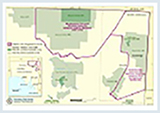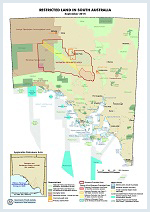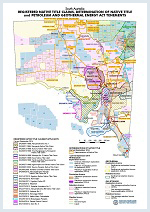On this page
Aboriginal Heritage
The function of the Aboriginal Heritage Act 1988 is for the protection of Aboriginal sites, objects and remains of significance to Aboriginal Archaeology, Anthropology, History and to Aboriginal Tradition.
The legislation and associated processes encourage companies to liaise with Aboriginal People to assist with the protection of Aboriginal heritage in South Australia.
Companies should contact the Department for Energy and Mining if they require assistance with identifying the appropriate Aboriginal People and communities. Sites discovered during operations are to be notified to the Minister (this is done through the Department of the Premier and Cabinet - Aboriginal Affairs and Reconciliation (AAR)). Penalties for damage to sites are A$50,000 in the case of a company, and A$10,000 or six months imprisonment in any other case. Statements of environmental objectives (SEOs) covering exploration and production activities carried out in licence areas list the legislation (including the Aboriginal Heritage Act 1988) that is relevant to these activities. Objectives aimed at avoiding disturbance to cultural heritage sites are also included in the SEOs.
Aboriginal Land
Aboriginal lands account for 22% of the State (map below). In South Australia there are three Acts which provide freehold tenure for Aboriginal People. These are the Aboriginal Lands Trust Act 2013, the Anangu Pitjantjatjara Land Rights Act 1981 and the Maralinga Tjarutja Land Rights Act 1984.
Aboriginal Lands Trust lands
The Aboriginal Lands Trust Act 2013 was the first Australian Government attempt to grant Aboriginal People title to land. The Trust was created to ensure that:
- title to existing Aboriginal reserves remained with Aboriginal People
- mineral royalty payments were received, with which more land could be purchased
- funds were received to develop lands vested in the Trust
Following the transfer of Aboriginal reserves and other areas of land to the Trust, the Trust leased the land back to the Aboriginal communities at nominal rates for 99-year, repeatedly renewable periods. Yalata (4516 km2) and Nantawarrina (580 km2) are the largest areas in the 5383 km2 of Trust land. Under the Act, the Trust is able, with Ministerial agreement, to sell, lease or mortgage the land vested in it. The sale of land requires the consent of both Houses of Parliament.
Access to Trust lands by exploration companies
Minerals on Trust lands remain the property of the Crown, but the South Australian Government and the Trust have signed an agreement to the effect that the Government will pay the Trust an amount equal to up to two thirds of all royalties it receives from mineral or petroleum developments on the lands. Aboriginal People who live in, or have association with, the area to be mined will receive 50% of the allocated royalties under the Energy Resources Act 2000.
In 1973 the Act was amended to provide protection of Trust lands from prospecting or mineral exploration unless the consent of the Trust and the traditional Aboriginal people had been obtained. A Trust policy is that no prospector, mining company or mineral exploration company will be permitted to enter Aboriginal lands vested in it without the Trust first obtaining consent of the Aboriginal community to whom the land has been leased.
Any land access granted by the Trust will be subject to terms and conditions mutually agreed upon by the Trust, the relevant Aboriginal community and the mining company, prior to commencement of any operations on the land. Terms and conditions may include compensation for damage to the land, restoration of the land, employment and training, and the safeguarding of sacred sites.
Anangu Pitjantjatjara Yankunytjatjara Lands
The Anangu Pitjantjatjara Yankunytjatjara (APY) Lands cover 102 630 km2 in the northwest corner of the State.
Following the recommendations of the Pitjantjatjara Land Rights Working Party, the Anangu Pitjantjatjara Yankunytjatjara Land Rights Act was passed in 1981, under which a corporate body, APY, holds the land in fee simple; the land cannot be sold, compulsorily acquired, resumed or forfeited, nor is land tax payable.
Access to Anangu Pitjantjatjara Yankunytjatjara lands by exploration companies
All non-APY people, except police, must apply for permission to enter the land. Exploration companies must first seek approval of the Minister for Energy and Mining before seeking permission to enter.
The Act requires APY 'to ascertain the wishes and opinions of traditional owners in relation to the management, use and control of the lands', a process requiring comprehensive consultative processes. The traditional owners have the right to seek compensation for disturbance to their ways of life which may result from the grant of the licence.
Having obtained permission of the Minister, a company may submit their application to the Executive Board of APY, which then has 120 days from the date of application to grant unconditional permission, permission subject to conditions or to refuse the application. If agreement cannot be reached on conditions of compensation, an appeal may be lodged with the Minister, who will appoint an arbitrator (having first considered representations from APY).
Royalties from minerals or petroleum are to be paid into a fund maintained by the Minister for Energy and Mining. These funds are to be divided evenly amongst APY, the Minister for Aboriginal Affairs and Reconciliation for the benefit of South Australian Aboriginal People, and to State Revenue (subject to prescribed limits).
Maralinga Lands
The Aboriginal People to the south of the APY Lands sought similar legislation and, in 1984, freehold titles were given to Maralinga Tjarutja, a corporate body established under the Maralinga Tjarutja Land Rights Act over an area of 80 764 km2.
Whilst generally similar to the Anangu Pitjantjatjara Yankunytjatjara Land Rights Act 1981 there are a number of differences, one of which is significant to exploration companies. The Maralinga Tjarutja Land Rights Act limits the payment of compensation for disturbance to the lands, the Aboriginal People and their ways of life from exploration operations to an amount no greater than compensation as provided for under the Mining Act 1971 and Energy Resources Act 2000.
Access to Maralinga Lands by exploration companies
Provisions in the Maralinga Tjarutja Land Rights Act relating to access for exploration companies are identical to those for Pitjantjatjara lands with the exception of appeals. Where an applicant feels aggrieved by a decision of Maralinga Tjarutja, the Minister for Energy and Mining with assistance from the Minister for Aboriginal Affairs and Reconciliation, attempt to resolve the matter by arbitration.
Aboriginal Policies on Mining
The 25th Annual Report of the Aboriginal Lands Trust for the year ending 30 June 1991 stated that ‘The Trust wishes to make it clear that it is not opposed in principle to mining on Aboriginal land, as long-term benefits to the Aboriginal People in the form of royalties and employment and training opportunities arising out of successful mining operations are apparent’.
The late Dr. Archie Barton AM, Administrator for Maralinga Tjarutja, in speaking about his organisation’s policy in December 1990 at the South Australian Department of Mines and Energy seminar, South Australia — Exploration Towards 2000, stated ‘Our office door is always open to those who are prepared to meet and visit the community to discuss these things (i.e. exploration)’. At the same seminar, Richard Bradshaw, a lawyer for Anangu Pitjantjatjara, stated that ‘Anangu Pitjantjatjara’s policy regarding petroleum exploration remains unchanged since 1984–85. In general terms, petroleum exploration appears to be more readily accommodated by the cultural and other restraints applying than exploration for other minerals’.
Petroleum exploration activity is currently being undertaken over Maralinga Tjarutja and Anangu Pitjantjatjara Yankunytjatjara Aboriginal lands in South Australia.
Native Title
The term 'native title' refers to those rights held by indigenous inhabitants of Australia at and since the time of European settlement that are recognised by the common law - it differs from conventional titles.
Native Title Legislation
The Native Title Act 1993 was passed by Commonwealth Parliament on 22 December 1993. This Act provides statutory recognition and protection for the concept of native title as recognised by the High Court in the case of Mabo v. The State of Queensland (1992). This Act was substantially amended in 1998. Amongst other things, these amendments inserted provisions for reaching indigenous land use agreements (ILUAs), provided more detailed provisions for dealing with acts which might affect native title, and provided a new test to be applied in the registration of claims for native title.
The term 'native title' refers to those rights held by indigenous inhabitants of Australia at and since the time of European settlement that are recognised by the common law - it differs from conventional land title. There must be a sufficient and relevant connection to the land in question, continuous since settlement (1836 in South Australia). The nature of native title rights vary from group to group according to laws and customs, and may include the right to camp or travel across land, rights to hunt, fish, gather food and take materials (timber, bark, ochre etc.) from the land.
Since the passage of the 1998 amendments, all applications in respect of native title under that Act are made as claims in the Federal Court (any claims made under the South Australian legislation [see below] are made in the Environment Resources and Development Court). The Federal Court refers claims for native title to the National Native Title Tribunal (NNTT) for registration. If the application passes the test, which now must be applied before registration, the details of the claim are entered on the Native Title Claims kept by the Tribunal. Registration is a pre-requisite for getting most of the rights conferred on claimants under the Native Title Act 1993, including the right to negotiate (RTN).
The National Native Title Tribunal also keeps the National Native Title Register which comprises a record of all determinations made by the NNTT, Federal Court, High Court, other Courts or Tribunals and recognised state and territory arbitral bodies.
The Native Title Act 1993, allowed for States to pass their own legislation in a number of areas. South Australia did so in 1994/95. This legislative package validated certain acts which occurred before 1994, allowed the State Environment Resources and Development and Supreme Courts to hear native title related issues (including determinations under the state RTN schemes) and set up alternative state RTN schemes under the Mining Act 1971 and the Land Acquisition Act 1969. A RTN scheme was later enacted as part of the Opal Mining Act 1995. No State RTN process was enacted for petroleum at that stage.
In so far as there is an impact on native title, the securing of native title land access agreements preceding issue of Petroleum Licences in this State continues to be governed by the federal RTN or Indigenous Land Use Agreement (ILUA) procedure.
The State Government is undertaking extensive consultation with all relevant organisations to establish ILUA’s over selected prospective areas of the state as a substitute for the RTN. The state government would only support such an ILUA if it were conjunctive.
Native Title Agreements
SA leads the way in Native Title agreements (PDF 57 KB)
Media release by Hon. Paul Holloway MLC - 20 March 2003
Native Title Agreement for the Officer Basin (PDF 45 KB)
Media release by Hon. Paul Holloway MLC - 10 December 2003
Historic Native Title Agreement for the Cooper Basin CO98 blocks (WORD 44 KB)
Media release by Wayne Matthew, Minister for Minerals and Energy - 22 October 2001
Indigenous Land Use Agreements (ILUAs)
In 2007 the National Native Title Tribunal registered the Indigenous Land Use Agreement (ILUA) with the Yandruwandha Yawarrawarrka Traditional Land Owners and that covers the eastern sector of the South Australian Cooper Basin.
This agreement is historic in that it is the first conjunctive petroleum land access agreement in a proven petroleum province, and provides for a template agreement that is evergreen and all encompassing in respect to enabling a prospective licensee to enjoin to enable subsequent licence grant without requiring an additional native title land access agreement.
Land Access Milestone for SA's Petroleum Industry (PDF 453 KB)
Announcement of the signing of the State's first Conjunctive Petroleum Indigenous Land Use Agreement (ILUA) over a portion of the Cooper Basin.
Media release by Hon. Paul Holloway Minister for Mineral Resources Development on 16 February 2007
Petroleum Conjunctive ILUAs
The following Petroleum Conjunctive Indigenous Land Use Agreements (ILUAs) are current over areas of land within South Australia:
- Yandruwandha/Yawarrawarrka; and
- Wangkangurru/Yarluyandi
The entire area of the Yandruwandha/Yawarrawarrka ILUA as well as a portion of the area of the Wangkangurru/Yarluyandi ILUA area are located within the Cooper Basin "Competitive Tender Region" pursuant to the Energy Resources Act 2000 and applications for petroleum exploration licences are only be accepted as a result of public calls for competitive work program bids.
For further information relating to the competitive work program bidding process, please refer to the Acreage Releases section of this website.
Downloads
- Yandruwandha/Yawarrawarrka Indigenous Land Use Agreement (PDF 2.4 MB)
- Wangkangurru/Yarluyandi Indigenous Land Use Agreement (PDF 6.3 MB)

Map of current Indigenous Land Use Agreements within South Australia (PDF 575)
For more information, contact:
-
Ms Lee KinnearGeneral ManagerEnergy Resources LicensingRegulation and Compliance Division
-
Ms Allison HarrisManagerEnergy Resources LicensingRegulation and Compliance Division




